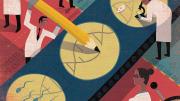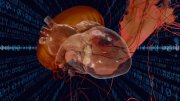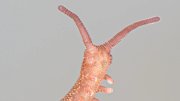The gene-editing technology CRISPR/Cas9 has been described as a word processor for DNA, but Kevin Eggan says it has all the finesse of a thermonuclear explosion. The professor of stem cell and regenerative biology has spent his career re-writing genomes, and he appreciates the accuracy with which the CRISPR “guide” sequence can home in on its target. But the second phase of the editing process, when the molecular scissors of the Cas9 enzyme slice through DNA, can introduce any number of unlooked-for errors. “Yes, I can precisely land the nuclear weapon,” he says, “but it’s still going to do a lot of damage.”
Editing errors waste time, money, and the lives of the lab animals that scientists like Eggan use to study diseases such as Alzheimer’s and ALS. Now, however, a new gene-editing technique called base editing, developed at the Broad Institute of MIT and Harvard in 2016 by professor of chemistry and chemical biology David R. Liu, promises far fewer off-target edits. Liu’s technique chemically alters DNA, letter by letter, instead of slicing through it. If CRISPR/Cas9 is a pair of scissors, base editing is an eraser and pencil. The greater precision of this new technique has emboldened Eggan to use it to alter sperm in order to create heritable changes in special breeds of research animals like mice that are then used to model diseases.
That could be a boon for biomedical research, but base editing for sperm alteration makes it more urgent to reckon with critical ethical questions, because it involves changes to the organism’s germline, the genetic information passed from one generation to the next. Germline editing could be used to cure human disease—but might also enable ethically fraught practices, such as human genetic enhancement.
“Yes, I can precisely land the nuclear weapon, but it’s still going to do a lot of damage.”
For now, researchers have limited themselves to the study of disease in cultured stem cells and lab animals. Among the sequences Liu has corrected with base-editing is APOE-ε4, a naturally-occurring gene variant that drastically increases the risk of Alzheimer’s disease. In fact, DNA sequencing has given scientists long lists of single-letter genetic variants associated with various diseases, like APOE-ε4, but the process of engineering the corresponding mouse models, says Eggan, “is too expensive and imprecise to study them all.” Most experiments require researchers to produce dozens of altered animals, but even in the CRISPR era, many of them will not carry the desired mutation. To speed things up, he and postdoctoral fellow Denis Vaughan wondered if they could use Liu’s base-editing technique to edit the sperm cells of mice carrying the APOE-ε4 sequence before fertilization, creating in a single breeding step a new strain of mice with the corrected sequence. That way, Eggan explains, “you could check to see whether the edit had worked or not before you make an animal.”
The research is still in progress, but he hopes APOE-ε4 editing will serve as a proof-of-concept, showing that mice can be cheaply produced to study the variants linked not only to Alzheimer’s but also to the countless other diseases associated with single-base genetic variants—potentially a major step forward in accelerating and reducing the costs of conducting basic research on these diseases.
The risk, of course, is that when it’s easier to edit the cells of non-human mammals, it becomes easier to edit human cells, too. Last year, when biophysicist Jiankui He announced the birth of the first human babies born with edited genomes, he was condemned for his experiment even by boosters of human genetic editing precisely because the twin girls’ genes showed many of the problems common to the use of CRISPR/Cas9. Not only were there editing errors at the target sites and elsewhere in the genome, but both girls had some edited and some unedited cells, a condition known as mosaicism that occurs when embryonic cells have started dividing before the CRISPR-induced edit is made.
Such complications show the immaturity of CRISPR technology, says George Daley, dean of Harvard Medical School. “We only have maybe five to six years of experience with this technology, and we’re still learning about it. There needs to be a far greater degree of expertise using this technique, especially in the context of embryo editing.”
Jeantine Lunshof, a biomedical philosopher and ethicist at MIT, suggests that improved tools like Liu’s, when used in applications such as sperm editing—in which edits can be completed, and verified, before the embryo starts dividing—may eventually alter the equation in human gene editing. But “only technically optimal interventions can be ethically justified,” she adds. “If further research shows that base-editing leads to the best and safest outcomes, this could be a criterion for ethical acceptability.”
Daley cautions, though, that even if the technology is optimized to minimize and ultimately reduce erroneous or missed edits, “We would still have to have a broader set of discussions about what society would accept for clinical use. The most compelling arguments could be made for coupling gene editing to in vitro fertilization and pre-implantation genetic diagnosis, to allow couples…burdened with genetic disease to have a healthy child.” Yet even that limited application involves determining what conditions indicate that medical intervention is permissible, and who is allowed to perform it. Both the technical development and the societal discussion must proceed with great caution, says Daley, but “great caution doesn’t mean forever a prohibition.”









